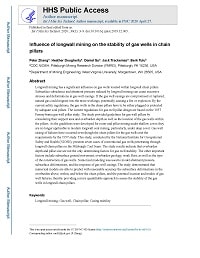Mining Publication: Influence of Longwall Mining on the Stability of Gas Wells in Chain Pillars
Original creation date: April 2020
Authors: Y Zhang, H Dougherty, W Su, J Trackemas, I Tulu
Longwall mining has a significant influence on gas wells located within longwall chain pillars. Subsurface subsidence and abutment pressure induced by longwall mining can cause excessive stresses and deformations in gas well casings. If the gas well casings are compromised or ruptured, natural gas could migrate into the mine workings, potentially causing a fire or explosion. By the current safety regulations, the gas wells in the chain pillars have to be either plugged or protected by adequate coal pillars. The current regulations for gas well pillar design are based on the 1957 Pennsylvania gas well pillar study. The study provided guidelines for gas well pillars by considering their support area and overburden depth as well as the location of the gas wells within the pillars. As the guidelines were developed for room-and pillar mining under shallow cover, they are no longer applicable to modern longwall coal mining, particularly, under deep cover. Gas well casing of failures have occurred even though the chain pillars for the gas wells met the requirements by the 1957 study. This study, conducted by the National Institute for Occupational Safety and Health (NIOSH), presents seven cases of conventional gas wells penetrating through longwall chain pillars in the Pittsburgh Coal Seam. The study results indicate that overburden depth and pillar size are not the only determining factors for gas well stability. The other important factors include subsurface ground movement, overburden geology, weak floor, as well as the type of the construction of gas wells. Numerical modeling was used to model abutment pressure, subsurface deformations, and the response of gas well casings. The study demonstrated that numerical models are able to predict with reasonable accuracy the subsurface deformations in the overburden above, within, and below the chain pillars, and the potential location and modes of gas well failures, thereby providing a more quantifiable approach to assess the stability of the gas wells in longwall chain pillars.

- Analysis of Global and Local Stress Changes in a Longwall Gateroad
- Degasification System Selection for U.S. Longwall Mines Using an Expert Classification System
- Development of Numerical Models to Investigate Permeability Changes and Gas Emission around Longwall Mining Panel
- Elastic and Shear Moduli of Coal Measure Rocks Derived from Basic Well Logs Using Fractal Statistics and Radial Basis Functions
- Evaluation of the Impact of Standing Support on Ground Behavior in Longwall Tailgates
- Longwall Retreat of Gate Road Pillars
- Modeling the Effects of Longwall Mining on the Ground Water System
- Numerical Simulation of Roof Cavings in Several Kuzbass Mines Using Finite-difference Continuum Damage Mechanics Approach
- Predicting Methane Emissions from Longer Longwall Faces by Analysis of Emission Contributors
- The State-of-the-Art in Coal Pillar Design